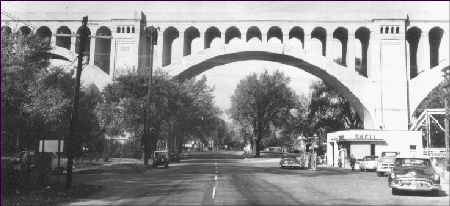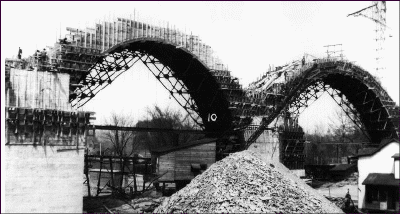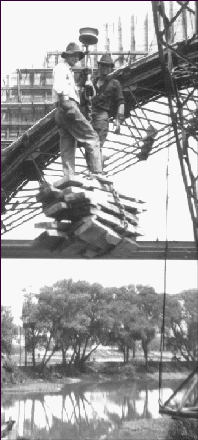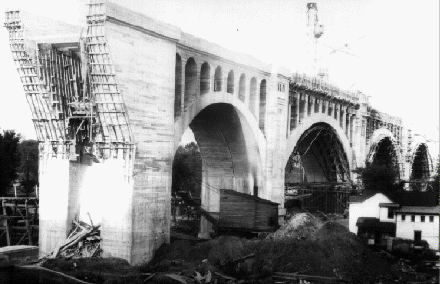
A distant-sounding horn floats over the south end of Sidney,
followed by an efficient, fluid rush of power. Few passersby take notice. Another CXS
freight train glides almost silently over the Big Four Bridge. The train hurries on to its
destination, fading from sight, and the giant bridge almost fades into the background.
Throughout its 75 year existence, this mammoth structure has physically defined our
skyline like nothing else. Its construction drew hundreds of onlookers on a regular basis
for two years. Its completion marked a milestone in bridge construction. As we press
forward into the 21st century, and our collective memories fade, the 'Big Four' Bridge
somehow seems less important. If only the old bridge could tell stories. Both
triumph and tragedy surrounded its building. Those details have been forgotten by most,
but an enduring mystery remains: Is there a body of a man somewhere within one of the
massive columns? Fiction or fact? Each reader must draw his or her own conclusion. This is
the checkered history of the building of the bridge.
The completion of the Sidney Feeder Canal through the town by the mid-1840's opened up commercial opportunities for local
businessmen and farmers, but it was the arrival of the railroads that signaled Sidney's
ascent as an early industrial powerhouse.
The Dayton and Michigan line connected Shelby County to the important northern and
southern markets by 1856, but the first company to launch the railroad era in Shelby County was the
Bellefontaine and Indiana. This line, which was later known as the Big Four Railroad, was
the east-west link through the county. Local attorney Hugh Thompson played a key role in
the formation of the Bellefontaine and Indiana. County voters supported the purchase of
stock in the fledgling railroad in the general elections of 1848 and 1850. Construction
was finished July 1853.
Financial difficulties caused the railroad to change hands several times. It was known
as the Cleveland, Cincinnati, Chicago and St. Louis (thus the Big Four Railroad), the Bee
Line, and after 1930, the New York Central Railroad.

The presence of Sidney in a natural valley created by the Great Miami
River presented challenges to the railroad builders, and ultimately proved to be a
major factor in the relocation of the tracks south of town across the Big Four bridge.
Ascending the grade out of Sidney either to the east or west was a continual challenge.
A second problem was the high incidence of injuries and deaths on the tracks in the
city. The tracks were laid in a series of curves through the river valley into Sidney and
center of town. The line went behind what is now Bridgeview School, over the Great Miami
River, and through what is now Tawawa Park.
Pedestrian, buggy and auto accidents with trains were common. The influential business
community was particularly hard-hit. Within a two year period of time, Robert Given, the
owner of R. Given and Sons Tannery, and his
sister, Isabella, were both killed by trains on the Big Four line. Charles Benjamin, the
founder of Benjamin 'D' Handle Company, was
also struck and seriously hurt a few years later.
The third and perhaps most decisive factor involved in relocating the Big Four tracks
out of downtown Sidney was the great flood of 1913. The
swirling waters washed out some of the track and disrupted operations. A decision was made
to relocate the tracks south of town.
The Big Four officials did not have in mind an ordinary bridge. To effectively span the
entire width of the valley required almost 14 miles of embankment. The project was slated
to take 2 years, and cost over 5 million dollars. There was to be a cost in human lives as
well.
The Walsh Construction Company of Iowa tackled the project. Hundreds of men, many
itinerant laborers, worked on the site. Long wooden trestles extended to the center of
what was to be the bridge from both ends. Dump or 'gondola' cars were backed across the
trestles to unload the thousands of tons of earth that would form the east and west
embankments. It was 75 years ago, during this phase of the construction, that the first
death occurred.
Lima resident
Henry Snyder was killed and co-worker Patrick Fitzgerald was seriously injured in June
1923 when one of the trestles on the east side of the river collapsed, sending the workers
to the ground almost 100 feet below. The next day's edition of the Sidney Daily News reported
that another worker, Sidney resident Joe Gilardi, narrowly escaped injury as the four
gondola cars tumbled from the collapsing trestle. Local residents Ed McVay and Harry Stahl
assisted in removing debris from the accident victims.
It was not a good week for trains in
Sidney. The previous Wednesday, a Western Ohio Railway train crashed at the corner of
Walnut Avenue and Court Street after the brakes on the train failed, killing one man.
The trestle was rebuilt after the June 1923 accident, and construction proceeded.
Massive concrete abutments began to take shape by the end of that year. During the immense
concrete pouring operations, tragedy struck the site again. Thomas Schmidt of Sidney was
working on top of one of the bridge abutments during the morning of January 30, 1924, when
he slipped and fell to his death.
Another near tragedy involved a passing motorist. W. H. Brandon and his wife left their
home in Troy to visit a son, who lived in Napolean, Ohio. Approaching the construction
site on county road 25A from the south, he did not see a watchman motion him to stop.
Brandon also did not see the rope stretched across the road until it was too late. The
rope sliced through the top of the auto, shearing it off like a can opener, and catching
the unfortunate Brandon under the chin. He escaped death, but was seriously injured.


In an eerie coincidence, almost a year
after Henry Snyder was killed by a collapsing trestle to the east of the bridge, tragedy
struck the work area on the west side of the structure. On May 12, 1924, witnesses heard
the shattering of wooden support braces, followed by the collapse of 125 feet of trestle.
Ten loaded gondola cars tumbled to the ground, carrying workers Verdit Williams and George
Bennet to their deaths. Neither man was from the area. The death toll was now four.
Around midnight on June 23, 1924, an incident occurred that added to the bridge's
turbulent and troubled history. As was reported in the Sidney Daily News the next
day, "Almost the entire city was aroused...by a terrific explosion, the likes of
which were never heard in this section." Shattered windows in the homes of Ed
McVay, Walter Brandenburg, Mrs. Lee, Ed Mc Clure and Wilbur Piper in the south end of town
provided the answer. Someone had tried to dynamite the Big Four Bridge!
An investigation by Police Chief
O'Leary and officials from Walsh Construction the next morning revealed that dynamite
had been wrapped in a leather pouch and placed on top of the center span of the bridge,
directly above County Road 25A. Additional fuse material was found over the span above the
river. No one was ever arrested and this crime was never solved.
What of the persistent rumor that swirled around the old bridge ever since construction
was completed in the fall of 1924? The Sidney Daily News carried a story on
November 12, 1923, in which a construction official was quoted as saying that the concrete
work was concluded, and that "There were no serious accidents among the 250 men
employed on the concrete portion of the work." Sidney resident Myron Chambers
recalls things differently.
Mr. Chambers
lived with his parents at 625 South Ohio Avenue. The children in the neighborhood were
fascinated by the construction project as it unfolded before them. He remembers the
trestle collapse in June 1923 and the death of Thomas Schmidt in the winter of 1924. His
most vivid recollection involves what he saw when the concrete arch nearest the west bank
of the Great Miami River was poured.
The five year old watched as the dump cars
carrying concrete were backed into place and unloaded. "I noticed a Mexican worker
walking a 2 by 10 plank across the opening of the arch," Mr. Chambers recalls. He
vividly remembers the worker falling forward into the concrete as the board flipped up.
"An effort was made to save him, but he was gone." In 20 minutes or so,
they began to pour concrete again. "I don't think they placed much value on the
lives of those immigrant workers," Mr. Chambers stated.
The massive project consumed 28,000 cubic yards of concrete and 900,000 pounds of
steel. The embankment contains over 1,000,000 cubic yards of dirt. The September 1924 Shelby County Democrat article announcing the completion of the work proclaimed it a
"stupendous piece of engineering work." In closing, the author reported
it was considered a "monument to the engineering profession." The Big
Four Bridge also serves as a monument to those men, whether identified or not, who died
during its construction.
[ Back to Landmark Index ] |

